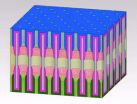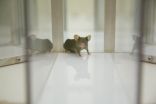Iron fertilization less efficient for deep-sea CO2 storage than previously thought?
New study reveals that iron fertilization in the Southern Ocean might reduce the efficiency of biological carbon pump in transporting carbon dioxide into the deep ocean
2014-11-10
(Press-News.org) The Southern Ocean plays an important role in the exchange of carbon dioxide between the atmosphere and the ocean. One aspect of this is the growth of phytoplankton, which acts as a natural sponge for carbon dioxide, drawing the troublesome greenhouse gas from the atmosphere into the sea. When these plankton die they can sink to the bottom of the ocean and store some of the carbon dioxide they have absorbed, a process scientists call the "biological carbon pump".
Although many areas of the Southern Ocean are rich in nutrients, they often lack iron, which limits phytoplankton growth. An important idea in oceanography is that adding iron to the Southern Ocean could stimulate phytoplankton growth and the biological carbon pump. Some scientists believe that this process can partly explain cycles in atmospheric carbon dioxide over Earth's recent history and it has also been widely debated as a mitigation strategy for climate change.
In two previous studies carried out in the last five years it has been shown that iron fertilization of the Southern Ocean can export carbon dioxide to the deep-sea. "However, to understand the net storage of carbon dioxide in the ocean interior, sinking phytoplankton are only one part of the story", explains Dr. Ian Salter from the Alfred Wegener Institute, Helmholtz Centre for Polar and Marine Research. "These phytoplankton can be a food source for certain types of planktonic grazers, foraminifer and pteropods, that make shells from calcium carbonate - a process which produces carbon dioxide".
The biogeochemist, and an international team of collaborators, were the first to quantify production and sinking of these calcium carbonate shells resulting from a phytoplankton bloom in the Southern Ocean, close to the Crozet Islands, with surprising results. Natural fertilization, caused by iron leached from the basaltic islands, increased the production and sinking of these calcium carbonate shells to a greater extent than sinking phytoplankton. This has important implications for the deep-sea storage of the carbon dioxide resulting from these blooms.
"The production and sinking of these calcium carbonate shells affects the balance of carbon dioxide in the surface ocean over 100 to 1000 year timescales", explains Dr. Ian Salter. "Our calculations suggest that this process reduces the amount of carbon dioxide transferred to the ocean interior via sinking phytoplankton by up to 30 per cent in this naturally fertilized system. However, it is unclear that purposefully added iron would have the same impact."
Interestingly the reduction in the efficiency of the biological carbon pump was not just caused by a higher abundance of these organisms, but also by changes in species composition. "In our samples from iron fertilized areas we found more species that produce larger calcium carbonate shells, and in turn produce more carbon dioxide per individual", explains the biogeochemist. Iron fertilization can therefore affect biodiversity and ecosystem structure with important knock-on effects for climate interactions. "It is important to recognise that our findings are only from a specific area of the Southern Ocean. The ecology of these shelled organisms can be very different depending on the species and exactly where in the ocean they live", cautions Dr. Ian Salter.
In future research projects Dr. Ian Salter will continue to investigate the sinking of phytoplankton and shelled calcifying organisms in other naturally iron-fertilized areas of the Southern Ocean, in addition to the Arctic Ocean, where melting sea ice conditions may also affect this delicate balance.
INFORMATION:
ELSE PRESS RELEASES FROM THIS DATE:
2014-11-10
Cold Spring Harbor, NY - Think about all the things you are doing at this moment. As your eyes scan across the lines of this article, maybe your brain is processing the smell of coffee brewing down the hall and the sound of leaf blowers outside your window. Maybe you are tapping your foot and spinning a pen between your fingers. At any given moment, your brain is simultaneously processing a multitude of information from your senses while supporting a dizzying array of behaviors.
How is all this information processed at once? The provisional answer, for decades, has centered ...
2014-11-10
COLLEGE PARK, Md. -- Researchers at the University of Maryland have invented a single tiny structure that includes all the components of a battery that they say could bring about the ultimate miniaturization of energy storage components.
The structure is called a nanopore: a tiny hole in a ceramic sheet that holds electrolyte to carry the electrical charge between nanotube electrodes at either end. The existing device is a test, but the bitsy battery performs well. First author Chanyuan Liu, a graduate student in materials science & engineering, says that it can be ...
2014-11-10
OAK RIDGE, Tenn., Nov. 10, 2014--For more than 50 years, scientists have debated what turns particular oxide insulators, in which electrons barely move, into metals, in which electrons flow freely. Some scientists sided with Nobel Prize-winning physicist Nevill Mott in thinking direct interactions between electrons were the key. Others believed, as did physicist Rudolf Peierls, that atomic vibrations and distortions trumped all. Now, a team led by the Department of Energy's Oak Ridge National Laboratory has made an important advancement in understanding a classic transition-metal ...
2014-11-10
Cold Spring Harbor, NY - There are roughly 20,000 genes and thousands of other regulatory "elements" stored within the three billion letters of the human genome. Genes encode information that is used to create proteins, while other genomic elements help regulate the activation of genes, among other tasks. Somehow all of this coded information within our DNA needs to be read by complex molecular machinery and transcribed into messages that can be used by our cells.
Usually, reading a gene is thought to be a lot like reading a sentence. The reading machinery is guided ...
2014-11-10
Thousands of never-before-seen genetic variants in the human genome have been uncovered using a new genome sequencing technology. These discoveries close many human genome mapping gaps that have long resisted sequencing.
The technique, called single-molecule, real-time DNA sequencing (SMRT), may now make it possible for researchers to identify potential genetic mutations behind many conditions whose genetic causes have long eluded scientists, said Evan Eichler, professor of genome sciences at the University of Washington, who led the team that conducted the study.
"We ...
2014-11-10
UCLA neuroscientists discovered that statins, a popular class of cholesterol drugs, reverse the learning deficits caused by a mutation linked to a common genetic cause of learning disabilities. Published in the Nov. 10 advance online edition of Nature Neuroscience, the findings were studied in mice genetically engineered to develop the disease, called Noonan syndrome.
The disorder can disrupt a child's development in many ways, often causing unusual facial features, short stature, heart defects and developmental delays. No treatment is currently available.
"Noonan ...
2014-11-10
Thanks to research performed at RIKEN's SACLA x-ray free electron laser facility in Japan, the dream of analyzing the structure of large, hard-to-crystallize proteins and other bio molecules has come one step closer to reality. In the study published in Nature Methods, researchers used a newly developed grease to suspend small crystals of lysozyme, glucose isomerase, thaumatin, and fatty acid-binding protein type-3, which they then analyzed using the revolutionary serial femtosecond crystallography method.
Crystallography, which was first performed just a century ago, ...
2014-11-10
A team of engineers and scientists has identified a source of electronic noise that could affect the functioning of instruments operating at very low temperatures, such as devices used in radio telescopes and advanced physics experiments.
The findings, detailed in the November 10 issue of the journal Nature Materials, could have implications for the future design of transistors and other electronic components.
The electronic noise the team identified is related to the temperature of the electrons in a given device, which in turn is governed by heat transfer due to packets ...
2014-11-10
In research published in Nature Chemical Biology, scientists from RIKEN in Japan have discovered a surprisingly simple mechanism through which enterics can adjust to the very different oxygen environments inside the human gut and outside. This research, which was led by Shigeyuki Yokoyama and Wataru Nishii of the Structural Biology Laboratory, opens a new potential target against these bacteria, which are the most-frequently encountered causative microorganisms of infectious diseases. The family includes well-known symbionts and facultative or obligate pathogens such as ...
2014-11-10
Boulder, Colo., USA - Scores of people were killed by an explosive eruption of Kīlauea Volcano, Hawai'i, in 1790. Research presented in GSA Bulletin by D.A. Swanson of the Hawaiian Volcano Observatory and colleagues suggests that most of the fatalities were caused by hot, rapidly moving surges of volcanic debris and steam that engulfed the victims. Deposits of such surges occur on the surface on the west summit area and cover an ash bed indented with human footprints.
The footprints, made by warriors and their families, appear along a major trail in use at the time. ...
LAST 30 PRESS RELEASES:
[Press-News.org] Iron fertilization less efficient for deep-sea CO2 storage than previously thought?
New study reveals that iron fertilization in the Southern Ocean might reduce the efficiency of biological carbon pump in transporting carbon dioxide into the deep ocean






